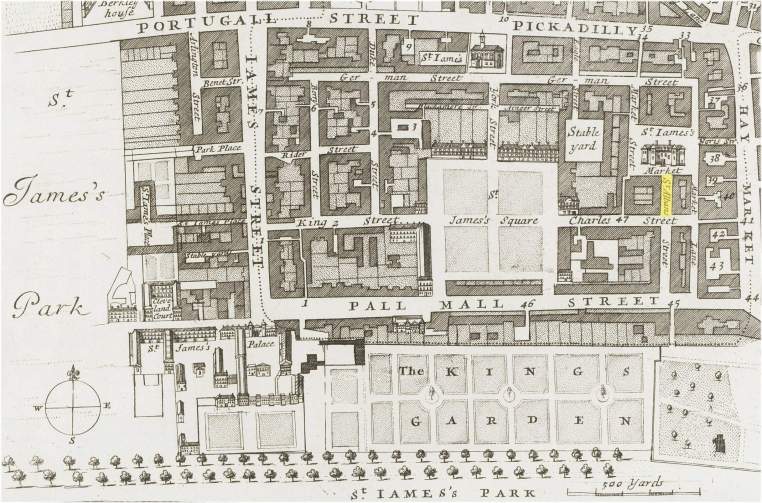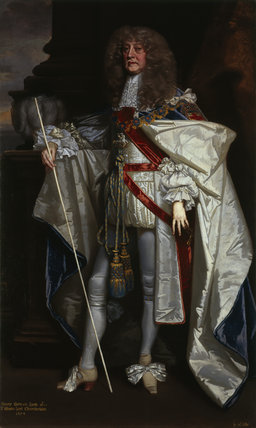
A half penny token issued in the name of George Carter in St. Alban‘s Street, Westminster
The above brass token measures 21.2 mm and weighs 1.51 grams. Based on it size alone it arguably best fits into the category of a penny token although that lack of it carrying a mark of value (as most penny token of the series do) probably means that it is more likely to be a half penny token. It was issued in the name of George Carter who was possibly a tavern owner operating from premisses in St. Alban’s Street, in the Parish of St. James, Westminster.
Obverse: (rosette) GEORG. CARTER. AT. YE. ST. ALBAN , around twisted wire inner circle, within the depiction of a standing figure (presumably St. Alban) facing and wearing a crown or peer’s coronet and holding a cross in its left hand and a sword in its right. What appears to be an open book on top of a draped alter or lectern is visible to the right of the figure.
Reverse: A legend in six lines reads IN .ST / ALBANS / STREET / NEERE. ST. / IAMES . / MARKET
It is possible that the George Carter recorded on the token was one and the same as the similarly named individual in the 1664 Hearth Tax return who is noted as occupying premisses with 15 hearths in Garndner Lane, St. Margret’s Parish, Westminster. While Hearth Tax returns were recorded for the eastern side of St. Albans Street in 1666 there are as then no occupants with the surname Carter.
St. Alban’s Street took its name from its developer and one of the area’s principal earliest inhabitants, Henry Jermyn, the 1st Earl of St Albans, a man sometimes refered to as the “Farther of the West End”.
In the 1650s the open space west of the Haymarket and north of Pall Mall, known at St. James’ or Pall Mall Fields was considered ripe for development but hitherto such had been forbidden by the Crown. In March 1661/2 the Earl of St Albans was granted a lease of much of this area by the Queen Mother. Development of the area was given further impetus in July 1662 when a meeting of commissioners for reforming the streets and buildings of London ordered the “paving of the way from St. James’, north, which was a quagmire, and also the Haymarket about Piqudillo”. A further Act of that same year also made provision for the paving of Pall Mall, the Haymarket and St. James’ Street. By September 1663 the development of St. James’s Fields by the Earl had begun. By April 1665, despite strong opposition, especially from the Lord Southampton who was a rival developer, Earl St. Albans obtained a freehold grant for over 11 acres (approximately half) of St. James’ Fields. On this land and his adjacent leaseholds he proposed a piazza, or square, of 13 to 14 houses, with subsidiary streets and plus a large covered market. This proposed development was similar to that of the Earl of Southampton’s estate of Bloomsbury. Despite some opposition and difficulties in 1665 Earl St. Albans had begun construction on his own house on his piazza, St. James’ Square. Completion of the square followed over the next decade or so.
By September 1665 a covered market (St. James’ Market) had been opened between the newly founded St. James Square and the Haymarket. The southern entrance to the market was connected to the west side of St. James’ Square via a short street (St. Albans Street) leading off King Charles Street. All of these streets were part of Earl St. Albans development of the area which the diarist Samuel Pepys comments on in his diary entry for the 1st April 1666;
“Up and down my Lord St. Alban his new building and market-house, looking to and again in every place building.”
In the 1666 Hearth Tax returns for St. Alban’s Street there are only entries for the eastern side of the street and some of these indicate that at that point in time several of the houses were recorded as newly built and still un-occupied. It is possible that by 1666 the western side of the street was still under construction and/or still comprised empty plots.
In Volume I of J.T. Smith’s 1846 publication “An Antiquarian Ramble in the Streets of London: With Anecdotes of Their More Celebrated Residents” reference is made to a mansion-house (supposedly once the residence of Earl St. Albans himself?) on the western corner of St. Albans Street at the junction with King Charles Streets which supposedly became a tavern and remained so until the building was demolished as part of improvements made to Reagent’s Street in 1820 and 1821. The same author associates this tavern as being the premises from which George Carter issued his undated trade token. As yet I have found nothing to confirm this one way or the other. That Early St. Albans took up residence in St. James Square c.1667 does not preclude him from living at the alternative address at a slightly earlier date of his development of this general area of St. James’ Fields.
There are several indicators that point to this token being issued relatively late in this mid-17th century series. These include;
1) The token’s reverse legend style
2) The identification of the token as possibly being of a penny denomination
3) The construction completion date of its street of issue
All of these factors point to a date of issue in the period 1667 to 1672.
At the time of this token’s issue the wording on its reverse side could be taken to indicate that many Londoners may not have known whereabouts its place of issue in the city was. Presumably while many people may not have heard of relatively new and obscure road by the name of St. Albans Street most of them will have been much more familiar with the neighbouring location of St. James Market.
While this token issue is the only one known from St. Albans Street there are over twenty types recorded from the neighbouring area of St. James Market-place. The earliest of these is dated 1664.


